By: Lisa Elizabeth Pius, Linda Jacob, Dr. Simi .P. Varghese, Dr. Reenu Raju, Dr. Anna Mathew, Mr. John Micheal Raj, Elizabeth Susan Varghese & Justy J. John
Introduction
Children are like wet cement, whatever falls on them makes an impression. Invasive procedures are daunting for children because of the generation of pain. Pain is a complex, multidimensional, and subjective experience that consists of physiological, sensory, emotional, cognitive,and behavioral components.1
The most frequently performed invasive procedures are venipuncture and intravenous placement of cannulae,2 and these are also the most painful and feared medical experiences of children.3 The increased association of pain in children is because the nervous system is vulnerable to noxious stimuli during development. The medical procedures induce
fear, anxiety, and behavioral distress in children and their families, further intensifying their pain and interfering with procedures.4 It has also been linked to fear, pain, and avoidance of medical care later in adulthood.5
Pharmacotherapy and distraction are the most common methods of pain control.6 Pharmacotherapeutic interventions include the use of topical anaesthetic creams. Although, pharmacotherapy interventions like topical anesthetic cream increases the speed at which procedures can be done, children are left in pain & distress.
Distraction is cognitive or behavioral strategy which draws the child’s attention away from noxious pain stimuli.1
Distraction techniques can be either active or passive. Active forms of distraction involve the child in some activity during procedure and include toys, electronic games, virtual reality, and passive forms of distraction including listening to music and watching animation.
The hypothesized mechanism of action is that a child “cannot attend to more than one significant stimulus at a time” and in keeping with the Gate Control Theory of Pain, distraction stimulates the brain stem, leading to inhibition of pain perception.7
Although distraction is widely recognized as an effective pain management strategy for children, certain types of distraction may be more effective than others, so comparison becomes important. This study was planned to find out which is the more effective distraction method for pain relief during intravenous cannulation of children in the paediatric ward of this institution.
Review of Literature
Pain is an inevitable and frequent part of life for all children. Infants and children, suffer from acute pain due to procedures like immunization, intravenous cannulation, trauma, and illness like otitis media, pharyngitis, as well as pain related to diseases. But needle pain is one of the most common acute pain experiences in pediatric primary and tertiary care settings.3 Still intravenous cannulation remains the most fearsome and daunting experience for them.7
Pate JT et al. found that child medical experience variables significantly predicted avoidance of medical situations in adulthood. That is adult fear, pain, and coping effectiveness are significantly predicted by child fear, pain, and coping effectiveness. Among all the three variables, child fear was found to be a significant predictor of avoidance of medical care. Also, traumatic child medical experience may lead to medical phobia that persists into adulthood.5
There are physiological and physical modalities tried to control and treat common medical pain in both children and adolescents. Physiological interventions available are providing information on procedure and treatment, distraction, slow rhythm breathing, relaxation, imagery, hypnosis, etc. The physical therapies used include application of cold and heat, pacifiers, rocking, sucking on sweet tasting solutions, and kangaroo mother care in premature infants. And the pain medications available include non-opioids like acetaminophen and NSAIDS, opioids (e.g.: Codeine and Morphine), and local and regional anesthetics (e.g.: lidocaine and EMLA). But the most thoroughly analyzed pain management strategy is distraction.6 There are also studies done comparing the role of distraction versus use of EMLA cream and typical standard care for pediatric pain management during immunizations.8 There is an abundance of literature supporting the efficacy of distraction as well.4,7,8 The basis of effectiveness of distraction points towards its ability to divert attention away from the painful stimuli. It was hypothesized that the brain has limited capacity to focus attention on painful stimuli. Therefore, it leaves little capacity for the child to attend the painful stimuli.7 James J et al, did a study to assess the effectiveness of animated cartoons as a distraction strategy to reduce behavioral response to perception of pain among 50 children of three to six years undergoing venipuncture. In that study it was found that children who underwent venipuncture with animated cartoon had significant less pain scores compared to routine care at before, during, and after venipuncture.4
There are also studies wherein different distractive strategies are used and compared against each other in pediatric pain management. Dalquist, et al. studied the effect of play with and interactive toys and head-mounted display helmet in controlling cold pressor pain.9 In a study done by Maclaren and Cohen, passive distraction like movies and active distraction like interactive toys were used to distract children.10
Even kaleidoscopes, distraction cards were used to reduce procedural pain and anxiety in children and distraction cards were found to be more effective for pain and anxiety relief during phlebotomy.11 In a randomized control trial by Meiri, et al., medical clowning was found to be effective in reducing the anxiety and duration of cry in children while undergoing venous blood drawing.12
CM McMurthy recommends specific policies to be implemented at the unit level which includes preparing a child using a multimodal approach. Staff are also recommended to be trained to use pain distress reducing cognitive, behavioral methods such as distraction, imagery, and relaxation.13 So, distraction should be routinely implemented during pediatric pain management. But there are different types of strategies which can be used for distracting children. Hence, in spite of distraction being widely recognized as an effective pain management strategy , certain types of distraction may be more effective than others, so comparison becomes important.This study was planned to find out which is the more effective distraction method for pain relief during intravenous cannulation of children in the pediatric ward of a rural tertiary care teaching hospital.
Objectives
To assess the role of listening to music compared to interactive play with an electronic toy, for pain and fear relief in children between the ages of two and seven years, undergoing insertion of a venous cannula in the pediatric ward of a rural tertiary care hospital. Pain will be rated on the FACES Wong Baker scale and fear on the Children’s Fear Scale (CFS).
Study Design
This is a parallel group, single blinded, randomized controlled trial undertaken on children between the ages of two and seven years admitted to the pediatric ward of this tertiary care hospital. This randomized control trial is registered with the Clinical Trial Registry of India.
Study Population
All children between the ages of two and seven years admitted to the pediatric ward of this institution undergoing venous cannulation are eligible.
Selection Criteria
Inclusion Criteria:
Children in the age group two to seven years having venous cannulation. Children were included if cannulation was achieved in the first or second prick.
Exclusion criteria:
Children who received paracetamol or pain-killers in the last four hours.
Children who were very sick.
Children with visual or hearing impairment.
Sampling: Children receiving venous cannulation were consecutively enrolled to the study if they fulfilled selection criteria and parents gave consent to the study.
Proposed Interventions were administered beginning one minute before the needle prick and continued three minutes after the needle prick.
The active intervention for Study Group A was playing actively with the child with an electronic toy operated in front of the child.
The passive intervention for Study Group B was a humorous children’s song in the local language, which was played to the child.
Instruments
-
Wong Baker @1983 FACES Pain Rating Scale was used with permission from the Authors.
-
Children’s Fear Scale (CFS)14
-
Case study form
Sample Size
The sample size was calculated using nMaster 2.0 software for nonparametric tests using the non Parametric Two Group Wilcoxon Mann Whitney U – Test.15
The Sample size is calculated for the true probability of observing the mean score (X) from Group A would be greater than the mean score (Y) of Group B i.e. P [A>B] > 1/2.
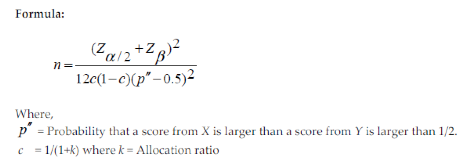
If we take the probability of observing X>Y is .72 the sample size for 80% power and 5% alfa error is 27 subjects in Group A and 27 subjects in Group B. As we randomised by computer generated permuted block randomisation in groups of four, the sample size was 28 in each group.
Study Procedure: The details of the study was explained to the parents of the child. Children were recruited into the study if parents gave written informed consent. The investigator played with the child and won the child’s co-operation and friendship before the study. The demographic data were collected in the case study form. The child was taken to the procedure room, comfortably placed on the table with the arm placed on the side. The FACES scale was used to record the child’s pain perception and CFS to record the child’s fear before cannula insertion when the child was comfortable.The use of an infant pacifier or pre-treatment with paracetamol were avoided.The procedure was done only when the child was fully awake as the state of wakefulness can modify the pain response. If the child was sleeping, we waited until the child woke up. The children were randomized by computer generated permuted block randomization16 into one of the two groups. The allocation to groups were concealed from the investigator by using sequentially numbered opaque sealed envelopes. The envelope, containing the group to which the child was allocated, was opened after the pre-procedural FACES and CFS scale were recorded by the student investigator. After the allocation to group, the particular distraction was used during the intravenous cannulation and the video of the process was taken.Later, FACES and CFS scale recording were taken at 0, one, and three minutes of needle prick by watching the video without the sound of cannulation by a blinded assessor.
Outcome Measure
The primary outcome variable was the acute behavioural pain response measured using FACES Pain Rating Scale. The FACES pain rating scale is graded from “no pain = 0” to “worst pain = 10.” The score obtained was compared with the FACES pre-intervention score.
The secondary outcome measure was the Child’s Fear Scale (CFS) to measure fear during procedural pain. The utility of a one-item measure of fear extends beyond the field of pediatric pain to other contexts including intervention for anxiety disorders and children in hospital.13
Statistical Analysis
All data were entered into a spreadsheet and analyzed using SPSS statistical software. The data was summarized and presented using tables, charts, and graphs. The demographic data in the two groups were compared for homogeneity with the Chi square test. The median pain scores on the FACES scale and the fear scores on the CFS were obtained. Difference between the preprocedural and post procedural scores were compared in the two groups using the Mann Whitney U-test. A ‘p’ value of 0.05 was considered significant.
Registration
The study was registered with the Clinical Trial Registry of India.
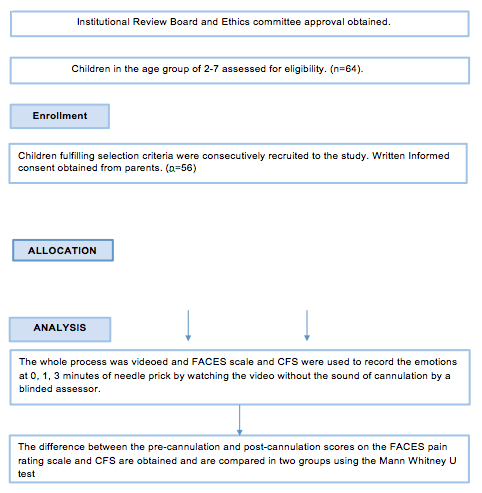
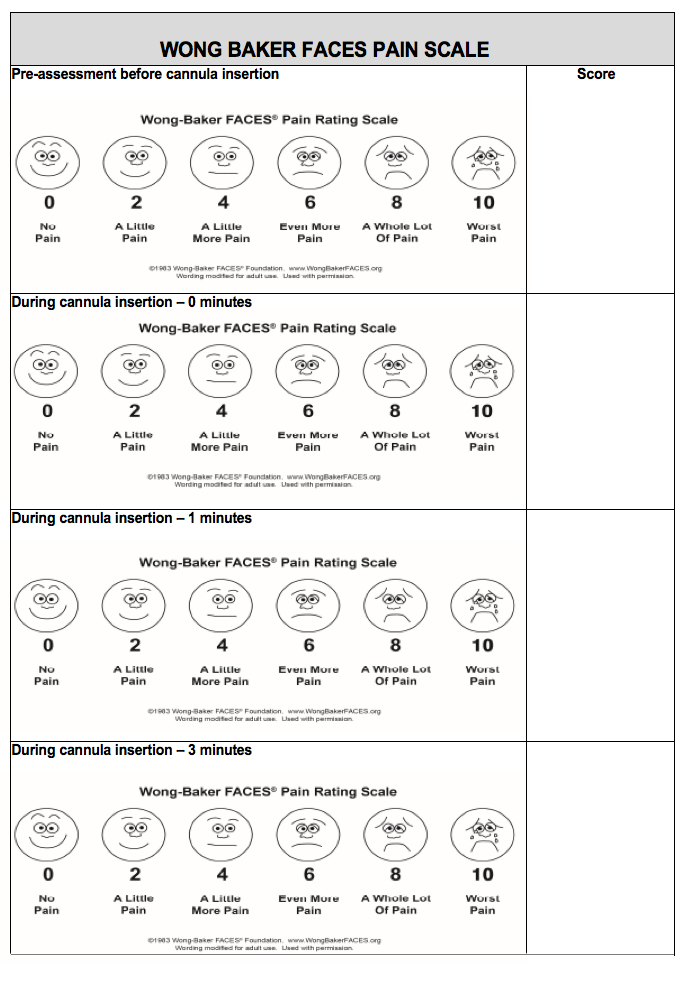
Fear Rating Scale
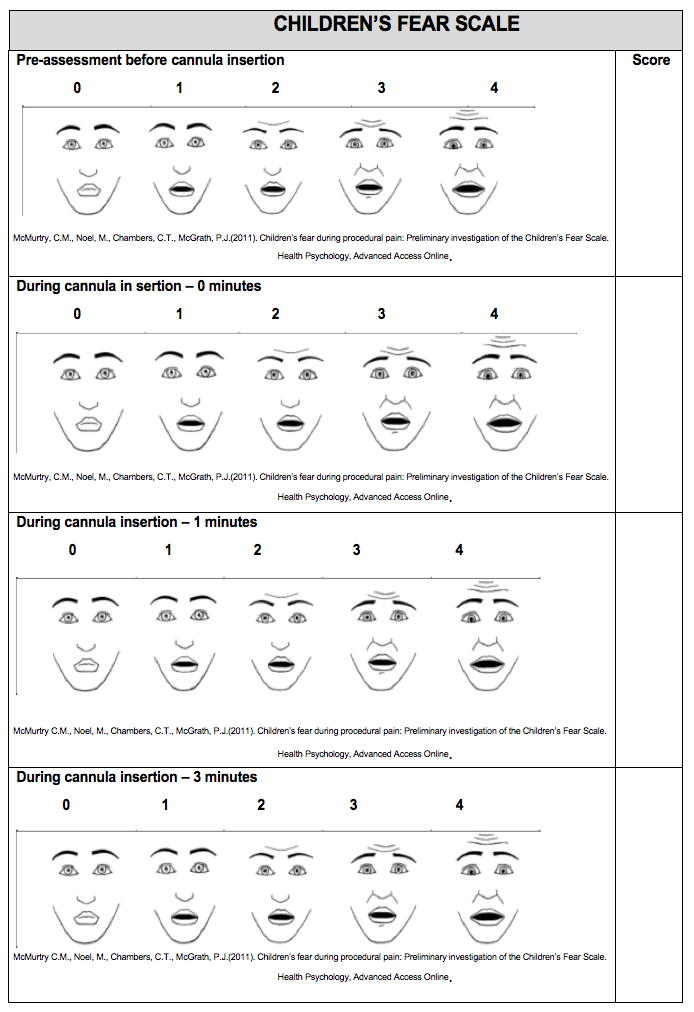
Observations and Results
In this study,we assessed the pain and fear scores before and after cannulation. The baseline characteristics are given in Table 1.
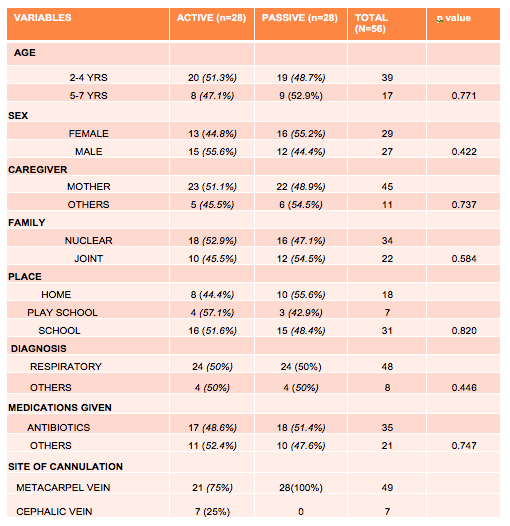
Figure 1: Previous History of Crying
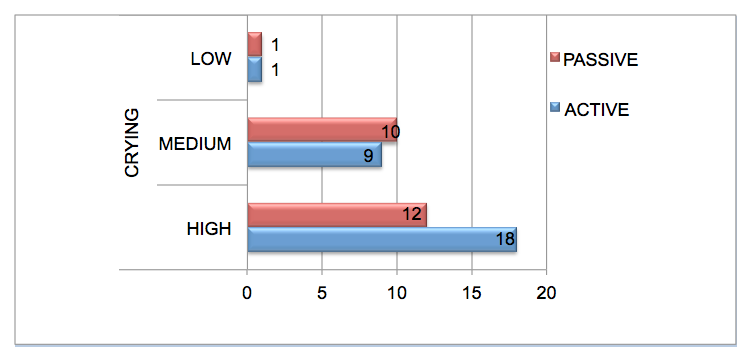
Legend Figure 1. It is observed that majority of children in both groups had a previous history of intense crying during cannulation.
Figure 2: Previous History of Pain Perception
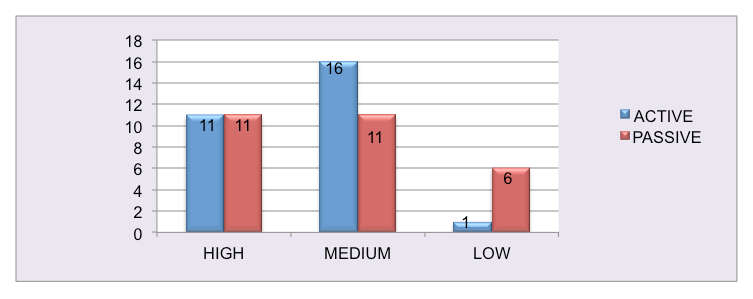
Figure 3: Trend In Reduction Of Pain Over Time
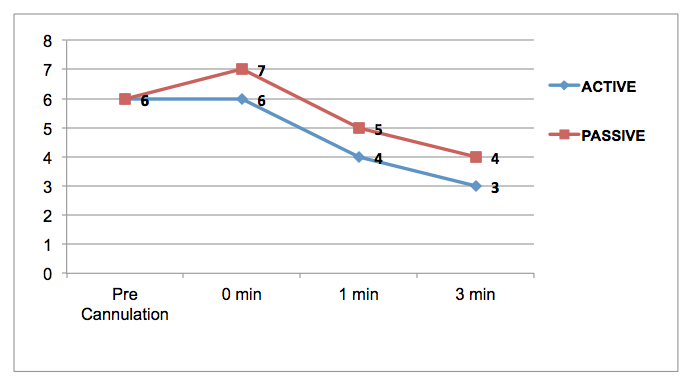 Legend Figure 3. It is observed that reduction in pain is more with active distraction.
Legend Figure 3. It is observed that reduction in pain is more with active distraction.
Figure 4:Trend In Reduction Of Fear Over Time
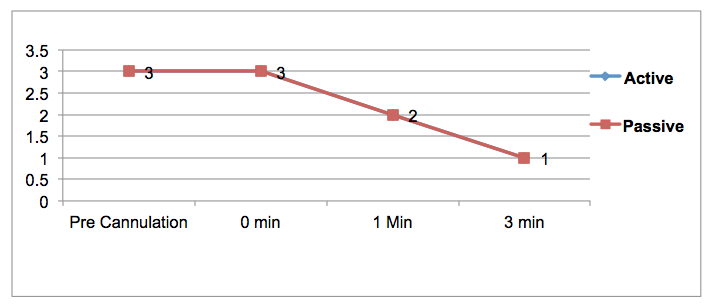
Legend Figure 4. It is observed that reduction in fear is same by both interventions.
Table 2: Difference Of Scores

Discussion
They were 56 children who participated in this study and most of them were in the age group of two to founr years, even though the study population included children between two to seven years of age.There were an equal number of girls and boys. Nearly half of the children from both groups had a previous history of moderate pain during previous cannulation,whereas most of them had a history of intense crying during previous intravenous cannulation. The majority of the children who participated in the study were diagnosed with respiratory problems and most commonly assessed vein was metacarpel vein. Considering the baseline characteristics of the active and passive groups, we found that both groups were homogenous.
We found that pain and fear were reduced after the active and passive intervention, as there was a sloping trend from pre-cannulation to post-cannulation pain and fear scores. Many studies have already proven distraction to be effective in reducing pain and fear during intravenous cannulation. In the comparative study by Cohen et al., it was found that child coping and distress significantly improved in the distraction group than in the control group receiving topical anesthesia during immunization.8 In a randomized control trial by Hartling, et al., music intervention was used to distract the children undergoing intravenous cannulation to assess the change in behavioral distress and pain scores. The change in pain scores were found to be statistically different between the groups favoring music intervention7.
In our study, the median difference from pre-cannulation to three minutes following were 4 (4,6) for active and 4 (2,4) for passive in FACES Pain Rating scale and 2 (1.5,3) for active and 2 (1,2) for passive in CFS. The ‘p’ values obtained were 0.039 (<0.05) in FACES Pain Rating scale and 0.146 (>0.05) in Children’s fear scale.It was found that in spite of both distractions reducing the pain and fear scores, active distraction reduced the pain scores more significantly than passive distraction.(p=0.039).This is in concordance with findings of a study done by Dahlquist et al., wherein distraction with interactive toys significantly improved pain tolerance and threshold in children experiencing cold pressor pain when compared with passive distraction.9 However, there are studies which prove passive distraction to be more effective. MacLaren and Cohen found movies decreased the venipuncture distress more significantly than the interactive toy. However, the children in the study were allowed to choose between the movies. The reason suggested by them included active distraction might be more demanding for some children experiencing pain.10
In our study, while assessing the secondary outcome, either of the distractions was not found to be statistically significant than one another in reducing fear scores, even though both reduced the fear scores. Similarly, in the study done by Hartling, the music intervention in spite of decreasing scores of behavioral distress, was not found to be statistically significant 7.
Previously published studies have reported that pain rating is influenced by some demographic variables including age.10 However, results of our study did not support these findings.
Conclusion
- There is effective pain relief with both interventions, with active distraction showing more reduction of pain. Both distractions are equally effective in reducing the associated fear.
- Anecdotal evidence provided by nurses showed that cannulation with distraction is easier.
- Both distractions are cost effective and can be easily implemented for the alleviation of pain and fear during intravenous cannulation in children.
Learning Experience
I learned the processes of doing a good clinical research and the procedure of a randomized control trial.I also developed the skill of observation to read the FACES scale accuratelty.
I also learnt how to communicate with the parents and how to reassure them when they see their child in pain.
Acknowledgements
I acknowledge the Dean, Management and Research Department, and the Department of Pediatrics at MOSC Medical College in Kolencherry, India.
Summary
Background
Invasive medical procedures induce pain and fear in children. Although distraction reduces pain, certain types of distraction may be more effective, so comparison becomes important.
Objectives
To assess the effectiveness of listening to music (passive) compared to interactive play with an electronic toy (active), for pain relief [rated on FACES Wong Baker scale (WBS)] and decreasing fear [scored on Children’s Fear Scale (CFS)] in pre-school children undergoing venous cannulation in the Paediatric ward of a rural tertiary care teaching hospital.
Methods
Parallel group, single blinded, randomized controlled trial was undertaken on preschool children between the ages of two to seven years admitted to the pediatric ward of MOSC MCH. sample size was calculated by using nMaster software by Non Parametric Two Group Wilcoxon Mann Whitney U – Test and was found to be 28 in each group. 56 children receiving venous cannulation were consecutively sampled as part of the study after obtaining parental consent. They were randomized by computer generated permuted block randomization into one of the two groups. The allocation was concealed from the investigator by using sequentially numbered opaque sealed envelopes. The envelope was opened after the pre-procedural WBS and CFS assessment. After allocation the particular distraction was used, and the WBS and CFS recording were taken at 0, three, and five minutes following the needle prick. The median scores on both scales were compared in the two groups using Mann-Whitney U test.
Results
The median difference from pre-cannulation to three minutes were 4 (4,6) for active and 4 (2,4) for passive in WBS and 2 (1.5,3) for active and 2 (1,2) for passive in CFS. The ‘p’ values obtained were 0.039 (<0.05) in WBS and 0.146 (>0.05) in CFS.
Conclusions
Active distraction relieves pain more effectively and both distractions reduce the associated fear equally. So, they can be easily implemented for alleviating pain and fear during intravenous cannulation in preschool children.
Works Cited
1. Koller D and Goldman RD Distraction techniques for children undergoing procedures: a critical review of pediatric research. J PediatrNurs2012; 27(6): 652–81.
2. Singer T, Seymour B, O’Doherty J et al. Empathy for pain involves the affective, but not sensory components of pain.Science.2004:303(5661):1157-62.
3. Jacobson S. Common Medical Pains. Paediatr Child Health.2007;12(2):105 9
4. James J, Ghai S, Rao KLN, Sharma N. Effectiveness of animated cartoons as a distraction
strategy on behavioural response to pain perception among children undergoing venipunture. Nursing and Midwifery Research Journal.2012; 4(3):1-8.
5. Pate JT, Blount RL, Cohen LL, Smith AJ. Childhood medical experience and temperament as predictors of adult functioning in medical situations. Child Health Care 1996;25:281-98.
6. Maclaren JE, Cohen LL. Interventions for paediatric procedure -related pain in primary care. Paediatr Child Health .2007;12(2):111-6.
7. Hartling L, Newton AS, Liang Y et al. Music to Reduce Pain and Distress in the Pediatric Emergency Department: A Randomized Clinical Trial. JAMA Pediatr. 2013;167(9):826-835. https://doi:10.1001/jamapediatrics.2013.200. Published online July 15, 2013.
8. Cohen LL Blount RL, Cohen RJ et al. Comparative study of distraction verses topical Anesthesia for pediatric pain management during immunization. Health Psychology 1999;18;591-8.
9. Dahlquist, L. M., McKenna, K. D., Jones, K. K., Dillinger, L., Weiss, K. E., & Ackerman, C. S. (2007). Active and passive distraction using a head-mounted display helmet: Effects on cold pressor pain in children. Health Psychology, 26(6), 794-801.
10. Maclaren JE, Cohen LL; A Comparison of Distraction Strategies for Venipuncture Distress in Children, Journal of Pediatric Psychology, Volume 30, Issue 5, 1 July 2005, Pages 387–396.
11. Nejla Canbulat, Sevil İnal, Hacer Sönmezer, Efficacy of Distraction Methods on Procedural Pain and Anxiety by Applying Distraction Cards and Kaleidoscope in Children, Asian Nursing Research.2014;8(1):23-8. ISSN 1976-1317. https://doi.org/10.1016/j.anr.2013.12.001
12. Meiri, N., Ankri, A., Hamad-Saied, M. et al. The effect of medical clowning on reducing pain, crying, and anxiety in children aged 2–10 years old undergoing venous blood drawing -- a randomized controlled study. Eur J Pediatr (2016) 175: 373. https://doi.org/10.1007/s00431-015-2652-z
13. McMurtry CM. Needle and dread: Is it just a little poke? A call for implementation of evidence-based policies for the management of needle pain in clinical settings. Paediatr Child Health 2007;12(2):101-102.
14. McMurtry CM, Noel M, Chambers CT, McGrath PJ. Children's fear during procedural pain: preliminary investigation of the Children's Fear Scale. Health Psychol. 2011 Nov;30(6):780-8
15.The Sample size was calculated by nMaster software, version 2.0 produced by the Department of Biostatistics, Christian Medical College, Vellore 632 002, Tamil Nadu
16.Efird J. Blocked Randomization with Randomly Selected Block Sizes. Intl J Environ Res Public Health 2011;8(1):15-20.


